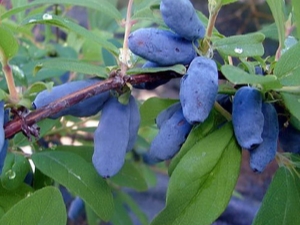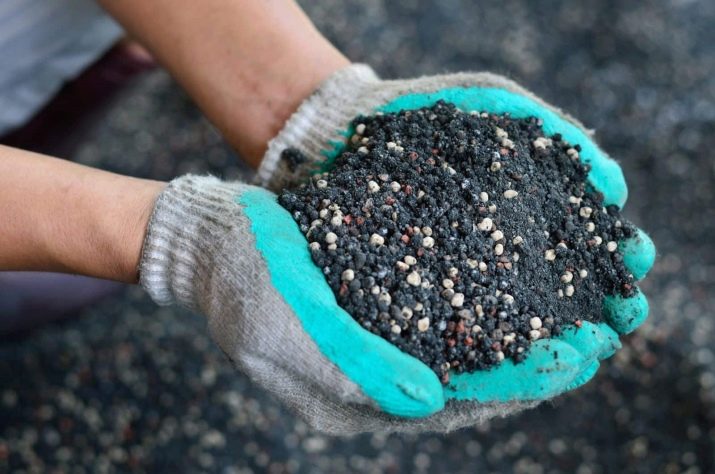Honeysuckle "Morena": characteristics, planting and care

The variety of honeysuckle "Morena" appeared at the end of the last century. It was bred in Russia, seedlings take root well and multiply in our climate.The berries grow large, so it is not surprising that this variety is very popular today.
Variety description
This variety was obtained by breeders from St. Petersburg; several specialists from the Federal Research Center Vavilov worked on it at once. Honeysuckle of this species grows well in almost every region of our country and gives a great harvest.
Shrubs plants reach a height of one hundred and seventy centimeters, which is quite impressive for such a berry. In diameter, shrubs reach one and a half meters, have the shape of a hemisphere. Large leaves are slightly folded along the midrib. The bark has a greenish-brown shade, the shoots smoothly bend. From the side you might think that this is an ornamental plant, so it is often used in the design of the landscape of the garden plot.
To get berries, this variety must be planted nearby with other types of honeysuckle, which are pollinators for it. Among them:
- "Viola";
- Malvina;
- "Blue Spindle", etc.
The terms of ripening and flowering of all these varieties of honeysuckle coincide with those of "Morena". Variety refers to the early ripening plants.
You can enjoy the fruits at the end of June, but most often the weather conditions and the region of cultivation influence the duration of the ripening of berries. The warmer, the faster the berries appear.
Experts describe the fruits of honeysuckle of this variety as large, up to 3 centimeters long. The weight of each berry can reach 2 grams. In shape, they resemble a jug, slightly stretched forward.
The color of the fruit is blue, the skin is firm enough so that you can easily transport the berries over long distances. The honeysuckle perfectly maintains a freezing for the winter, at the same time in full volume keeps the useful properties. A distinctive feature of the fruit can be considered the absence of a bitter taste. Berry has a sweet-sour taste, tender pulp. As for the flavor, it is not pronounced.
On average, the yield of one bush is 2.5 kilograms. The fruits are not immediately showered after ripening, so the gardener always has time to collect them. All berries are sown almost simultaneously, so the harvest is fast - within a few days.
How to plant?
Of course, you can use the blueberry shrub solely as a design solution. Then there will be no questions about where to plant and whether it is necessary to prepare the soil. However, most gardeners pursue other goals and want to get a good harvest. Only a correctly chosen place with fertile soil can guarantee a high level of fruiting.
Honeysuckle - a plant that is very fond of the sun, and therefore the landing area should not be shaded. Penumbra causes the formation of small and sour berries that do not have a pleasant taste. Bypass those areas where melt water accumulates: even the love of this plant for moisture is not enough for it to grow in such conditions.
The process of planting is the same as in the case of any berry shrub. From the gardener will only need to take into account for the future that the bushes will be of impressive size, respectively, and the distance between them must be provided appropriate.
If you want to organize a hedge, then the plants are planted at a distance of one and a half meters from each other. If the main goal is the harvest, it increases to two meters, that is enough for the full development of the shrub.
Planting is done in autumn or spring, while the bushes are at rest and sap flow has not started, otherwise the root system will not survive the stress. Compliance with these simple requirements simplifies the gardener with the process of caring for honeysuckle, the quality of fruits increases significantly, and within a few years you can boast large berries with a sweet and sweet taste.Deviation from the rules of agricultural engineering will lead to failure, in which the gardener is to blame.
One of the main advantages of the variety is its unpretentiousness. Shrubs can grow freely on stony and even clayey soil, but juicy, large fruits will be only if there is enough sun over the plant, and the soil is well fertilized.
It is worth planting in open ground or cutting:
- in the spring, before the first buds appear;
- in the fall, until the first frost came.
The hole is to dig 50 centimeters deep and the same diameter.
The plant is very fond of fertilized soil, so it is advised to pour a bucket of humus inside the grooves, you can use compost. Do not interfere and one hundred grams of superphosphate and potassium sulfate in the amount of 30 grams.
The stem is located in the center, and the root system is distributed along the edges of the fossa. The soil can be slightly compacted and must be watered, and then grinded. Transplantation will not be needed soon, since the honeysuckle can produce a high-quality crop for twenty years in one place.
How to care?
Care is one of the most difficult tasks that need to be addressed by a gardener. It is necessary to thin out and form bushes, otherwise they will grow and cause a lot of trouble. In the spring, the shrub quickly seeks to give the first foliage and additional shoots, so it is pruned in the fall, when all the leaves have fallen.
The first few years of plant growth you can do nothing, especially you can not touch the young shoots, because the bush will give the crop on last year, covered with tree bark branches. Pruning them in the fall, the gardener will deprive himself of the next harvest, without knowing it. That is why the formation of a bush begins only four years after planting a young plant.
Delete:
- located near the ground and tilted shoots;
- everything that began to grow inside an educated bush;
- dry and broken processes;
- thick, old and stunted branches.
If the bush does not have enough young shoots that can be considered reproductive, it is better not to touch the old ones, it is enough to shorten them.
Another feature of honeysuckle care is the timely application of fertilizers. In early spring, it is not recommended to use nitrogen supplements, it is better to use simple ash. It will allow to get a good harvest at the beginning of summer, because it contains:
- potassium;
- trace elements;
- phosphorus.
All of them are necessary both at the stage of the formation of flower buds and during the fruiting period. There are no special rules for the introduction of ash into the soil, it can simply be scattered on the last, already thawing snow under the bushes. As soon as the soil warms up a little, it is loosened and compost or humus is introduced.
To support the plant, you can begin to make nitrogen from the age of three, but do not overdo it. Once a year is enough.
Most of the bushes need phosphorus and potassium, since these two elements are responsible for setting and forming berries.
It is necessary to ensure honeysuckle quality irrigation in the fall, after harvest. Each bush leaves up to three buckets of water, but the rate may differ depending on the ability of the soil to absorb moisture.
Practically it is not necessary to process bushes from pests and diseases, since this plant does not interest either those or others. However, when it is cold and damp outside, there may be problems with powdery mildew, aphids or spider mites. Can be used for the treatment of drugs such as "Topaz", "Alto", "Skor". The procedure is carried out exclusively after harvesting, the berries are in no way sprayed, otherwise they become unsuitable for consumption.
The described variety is resistant to frost and easily adapts to the harsh climate.
Collection, storage and reviews
A short period of harvest hurries the gardener. Despite the fact that the berries can be on the branches for a long time, the birds will soon want to feast on them.
In the fridge fresh honeysuckle is stored for no more than two days, which is why it is recommended to freeze it for subsequent use in compotes or immediately cook juices, jams, etc. Even after defrosting, the form remains, berries do not flow.
It is very useful to use fresh berries, because it contains a huge amount of vitamins and substances that activate the human immune system.
Cocktails with milk, fruit drinks, smoothies - all this has an amazing aroma, if you add a little honeysuckle there or use it as a main component.
With the help of dried fruit, you can insist teas, cook compotes. Useful properties and vitamins are preserved. Berry contains a lot of tannins, acids, you can cook drinks for diabetics without adding sugar.
"Morena" - one of the best artificially bred varieties of honeysuckle according to professional gardeners. It is suitable for any region, perfectly adapts to frosts and any temperature changes.
Even under adverse environmental conditions, when other berries cease to produce a stable crop, this plant continues to bear fruit in large quantities. The variety is an excellent pollinator and even the fact that it is not the most productive species does not affect the popularity of the Morena, because it is stable, and this is important.
The life of the plant is such that enough for several generations, honeysuckle picky and requires attention only a few years after planting. There is no alternative to this variety, although breeders are not trying to get a more reproductive form of honeysuckle, but with the same resistance to temperature changes and pests. Shrubs delight not only delicious fruits, but also beautiful decorative views, they are ideal for decorating the yard. Any gardener will be able to get a decent harvest, if he puts a minimum of effort into this and takes into account the peculiarities of the Morena.
You can learn more about this variety of honeysuckle in the next video.



































